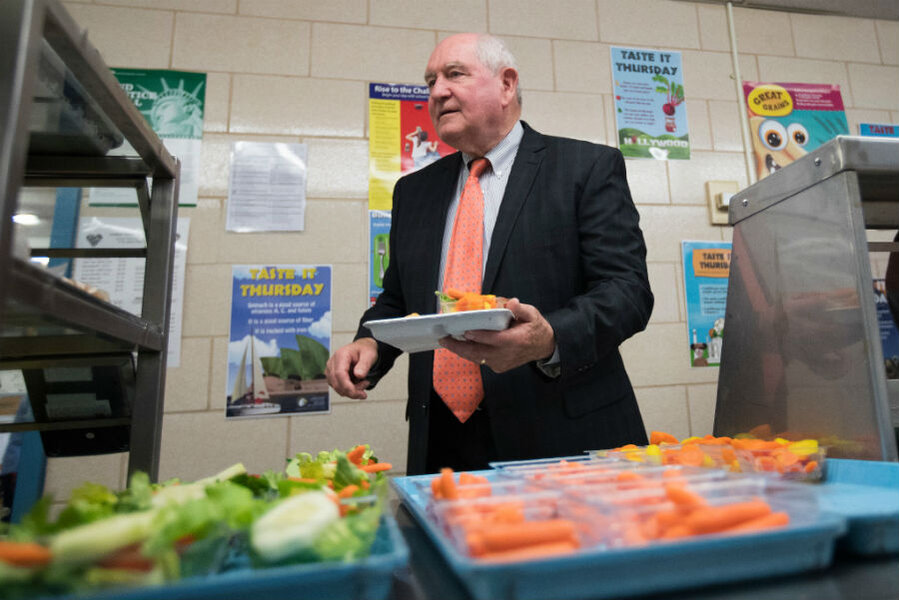USDA secretary announces halt on school nutrition standards
Loading...
United States Department of Agriculture secretary Sonny Perdue has had a busy first week. Only six days after his appointment to the new position, Mr. Perdue announced Monday that he would roll back Obama-era school nutrition standards, a move that has prompted criticism from a number of nutrition experts around the country.
Perdue called for a relaxation of the standards in the Healthy, Hunger-Free Kids Act introduced in 2010, which had been championed by both former President Barack Obama and former first lady Michelle Obama. The rollback would reduce whole-grain requirements, allow higher levels of sodium entrees, and restore higher-fat and sweetened milk to school cafeterias nationwide.
Critics of the move point to high rates of obesity among American children, with many Democrats saying the rollback is part of a reckless and irresponsible anti-regulatory crusade on behalf of the Republican Party. But defenders of Perdue's new plan say that halting the plan will loosen overly restrictive legislation that leaves schools with food students often refuse to eat.
"This announcement is the result of years of feedback from students, schools, and food service experts about the challenges they are facing in meeting the final regulations for school meals," Perdue said in a statement during a visit to Catoctin Elementary School in Leesburg, Va. "If kids aren't eating the food, and it's ending up in the trash, they aren't getting any nutrition – thus undermining the intent of the program."
There is at least some peer-reviewed journal evidence to support the notion that younger children tend to enjoy less healthy food, says Angie Griffin, a nutrition expert and assistant clinical professor at Texas Woman's University. But that does not mean that schools should return to older, less healthy menus, she adds.
"[Studies show] that for some students it's the only nutritious food consumed throughout the day," Ms. Griffin tells The Christian Science Monitor in an email.
And for many poor students, a school lunch is the only meal that can be counted on as a regular source of food, she adds, making school food nutrition an important social and nutritional component of young children's lives – something that she says cannot simply be ignored to make things a little easier on school pocketbooks.
Despite the importance of the school food for many students, proponents of the change argue that it's sometimes challenging for budget-strapped schools to create meals from fresh ingredients. With current funding levels, many schools may find it easier to rely on cheaper, mass-produced meals. While government subsidies do exist for the purpose of providing healthier meals to students, some school districts have found themselves coming up short.
Unfortunately, say some experts, it's often the schools whose students most need nutritious lunches that have the hardest time serving them. "The only advantage to offering less healthy options is a balanced school budget," says Kristen Linton, a professor of Health Science at California State University, Channel Islands.
Dr. Linton tells the Monitor that lower-income school districts with large student body populations in particular tend to struggle when it comes to serving healthy options. She gives the example of a local high school district in Southern California, which has the second-highest obesity rate in the state:
"Eighty percent of the students at this school district qualify for free or reduced school lunch. The school district is reimbursed $3.16 for those who qualify for free lunch and $2.76 for those who qualify for reduced lunch for 2016-2017. Thus, the school nutrition services must plan healthy, balanced lunches that cost generally $3.16 or less per student. That is no easy task given that they are required to also meet other dietary, caloric requirements by the state as well. School districts with fewer students who qualify for free or reduced school lunch would have higher budgets and more flexibility to offer healthier options."
Since the 1970s, the childhood obesity rate in the US has more than tripled, a trend that the Healthy, Hunger-Free Kids Act was created to reverse. The 2010 bill drew bipartisan support, though it received some resistance from lobbying groups such as the School Nutrition Association, and some house Republicans. Now, however, 97 percent of schools in the US are implementing the standards set by the act, though Perdue's announcement is likely to keep that implementation from ever reaching 100 percent.
"The standards that were enacted during the past eight years have helped to improve the quality of food so that there is less sugar, less saturated fat, less sodium, but more vegetables, fruits, and whole grains – with many new and tasty recipes being used," Miriam Nelson, nutritionist and director of the Sustainability Institute at the University of New Hampshire, tells the Monitor in an email. "Our children matter, so society should care about what our children are fed."








